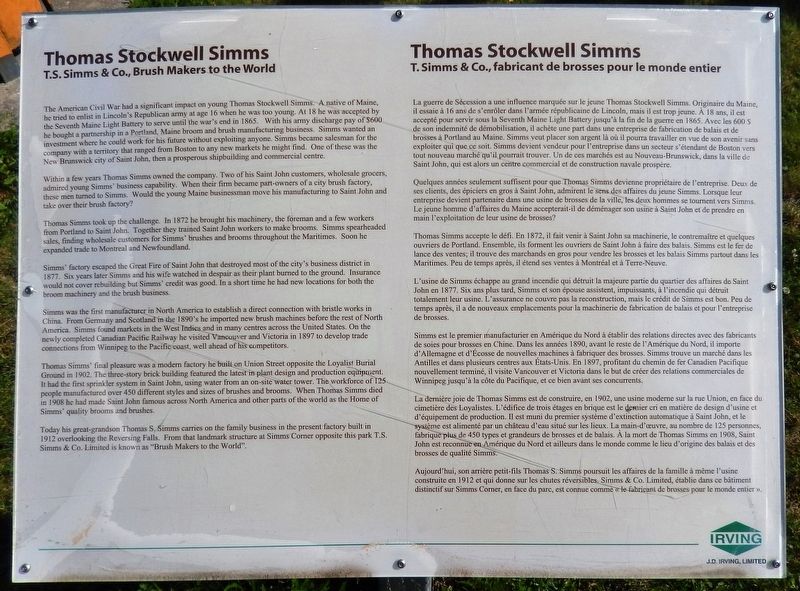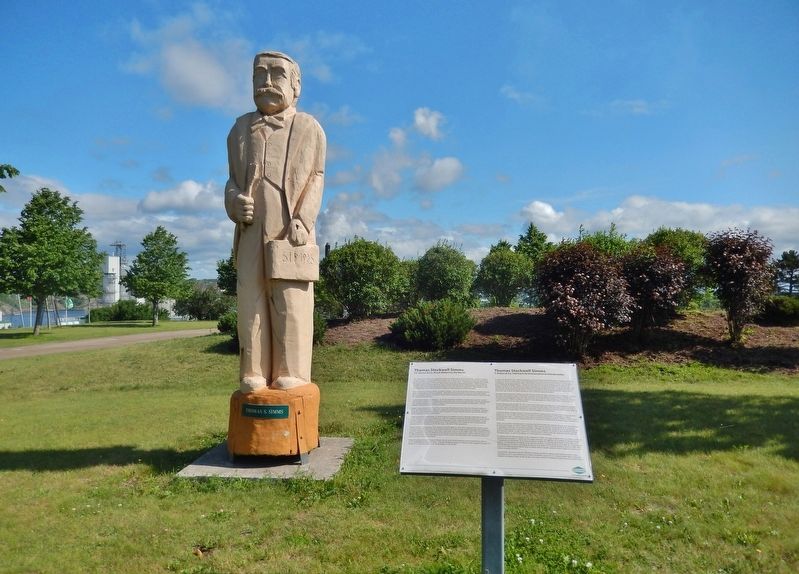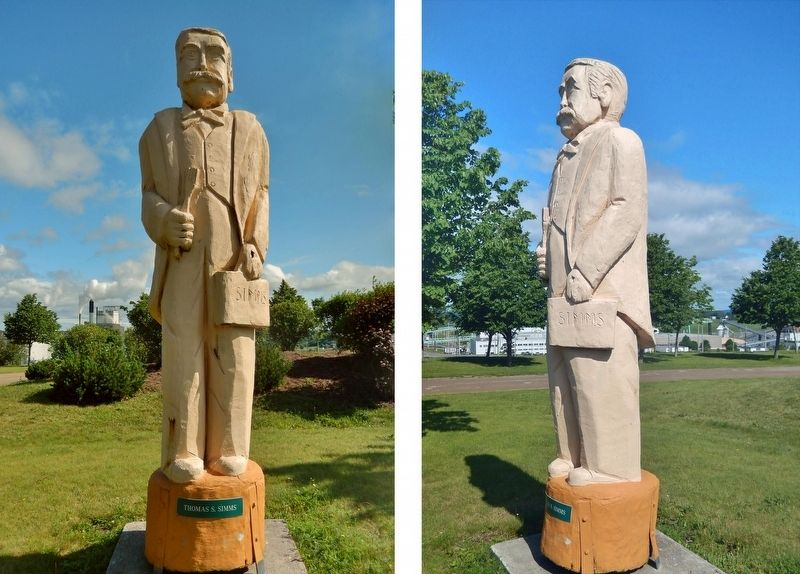Saint John in Saint John County, New Brunswick — The Atlantic Provinces (North America)
Thomas Stockwell Simms
T.S. Simms & Co., Brush Makers to the World / fabricant de brosses pour le monde entier
The American Civil War had a significant impact on young Thomas Stockwell Simms. A native of Maine, he tried to enlist in Lincoln's Republican army at age 16 when he was too young. At 18 he was accepted by the Seventh Maine Light Battery to serve until the war's end in 1865. With his army discharge pay of $600 he bought a partnership in a Portland, Maine broom and brush manufacturing business. Simms wanted an investment where he could work for his future without exploiting anyone. Simms became salesman for the company with a territory that ranged from Boston to any new markets he might find. One of these was the New Brunswick city of Saint John, then a prosperous shipbuilding and commercial centre.
Within a few years Thomas Simms owned the company. Two of his Saint John customers, wholesale grocers, admired young Simms' business capability. When their firm became part-owners of a city brush factory, these men turned to Simms. Would the young Maine businessman move his manufacturing to Saint John and take over their brush factory?
Thomas Simms took up the challenge. In 1872 he brought his machinery, the foreman and a few workers from Portland to Saint John. Together they trained Saint John workers to make brooms. Simms spearheaded sales, finding wholesale customers for Simms' brushes and brooms throughout the Maritimes. Soon he expanded trade to Montreal and Newfoundland.
Simms' factory escaped the Great Fire of Saint John that destroyed most of the city's business district in 1877. Six years later Simms and his wife watched in despair as their plant burned to the ground. Insurance would not cover rebuilding but Simms' credit was good. In a short time he had new locations for both the broom machinery and the brush business.
Simms was the first manufacturer in North America to establish a direct connection with bristle works in China. From Germany and Scotland in the 1890's he imported new brush machines before the rest of North America. Simms found markets in the West Indies and in many centres across the United States. On the newly completed Canadian Pacific Railway he visited Vancouver and Victoria in 1897 to develop trade connections from Winnipeg to the Pacific coast, well ahead of his competitors.
Thomas Simms' final pleasure was a modern factory he built on Union Street opposite the Loyalist Burial Ground in 1902. The three-story brick building featured the latest in plant design and production equipment. It had the first sprinkler system in Saint John, using water from an on-site water tower. The workforce of 125 people manufactured over 450 different styles and sizes of brushes and brooms. When Thomas Simms died in 1908 he had made Saint John famous across North America and other parts of the world as the Home of Simms' quality brooms and brushes.
Today his great-grandson Thomas S. Simms carries on the family business in the present factory built in 1912 overlooking the Reversing Falls. From that landmark structure at Simms Corner opposite this park T.S. Simms & Co. Limited is known as "Brush Makers to the World".
La guerre de Sécession a une influence marquée sur le jeune Thomas Stockwell Simms. Originaire du Maine, il essaie à 16 ans de s'enrôler dans l'armée républicaine de Lincoln, mais il est trop jeune. À 18 ans, il est accepté pour servir sous la Seventh Maine Light Battery jusqu'à la fin de la guerre en 1865. Avec les 600 $ de son indemnité de démobilisation, il achète une part dans une entreprise de fabrication de balais et de brosses à Portland au Maine. Simms veut placer son argent là où il pourra travailler en vue de son avenir sans exploiter qui que ce soit. Simms devient vendeur pour l'entreprise dans un secteur s'étendant de Boston vers tout nouveau marché qu'il pourrait trouver. Un de ces marchés est au Nouveau-Brunswick, dans la ville de Saint John, qui est alors un centre commercial et de construction navale prospère.
Quelques années seulement suffisent pour que Thomas Simms devienne propriétaire de l'entreprise. Deux de ses clients, des épiciers en gros à Saint John, admirent le sens des affaires du jeune Simms. Lorsque leur entreprise devient partenaire dans une usine de brosses de la ville, les deux hommes se tournent vers Simms. Le jeune homme d'affaires du Maine accepterait-il de déménager son usine à Saint John et de prendre en main l'exploitation de leur usine de brosses?
Thomas Simms accepte le défi. En 1872, il fait venir à Saint John sa machinerie, le contremaître et quelques ouvriers de Portland. Ensemble, ils forment les ouvriers de Saint John à faire des balais. Simms est le fer de lance des ventes; il trouve des marchands en gros pour vendre les brosses et les balais Simms partout dans les Maritimes. Peu de temps après, il étend ses ventes à Montréal et à Terre-Neuve.
L'usine de Simms échappe au grand incendie qui détruit la majeure partie du quartier des affaires de Saint John en 1877. Six ans plus tard, Simms et son épouse assistent, impuissants, à l'incendie qui détruit totalement leur usine. L'assurance ne couvre pas la reconstruction, mais le crédit de Simms est bon. Peu de temps après, il a de nouveaux emplacements pour la machinerie de fabrication de balais et pour l'entreprise de brosses.
Simms est le premier Manufacturier en Amérique du Nord à établir des relations directes avec des fabricants de soies pour brosses en Chine. Dans les années 1890, avant le reste de l'Amérique du Nord, il importe d'Allemagne et d'Écosse de nouvelles machines à fabriquer des brosses. Simms trouve un marché dans les Antilles et dans plusieurs centres aux États-Unis. En 1897, profitant du chemin de fer Canadien Pacifique nouvellement terminé, il visite Vancouver et Victoria dans le but de créer des relations commerciales de Winnipeg jusqu'à la côte du Pacifique, et ce bien avant ses concurrents.
La dernière joie de Thomas Simms est de construire, en 1902, une usine moderne sur la rue Union, en face du cimetière des Loyalistes. L'édifice de trois étages en brique est le dernier cri en matière de design d'usine et d'équipement de production. Il est muni du premier système d'extinction automatique à Saint John, et le système est alimenté par un château d'eau situé sur les lieux. La main-d'œuvre, au nombre de 125 personnes, fabrique plus de 450 types et grandeurs de brosses et de balais. À la mort de Thomas Simms en 1908, Saint John est reconnue Amérique du Nord et ailleurs dans le monde comme le lieu d'origine des balais et des brosses de qualité Simms.
Aujourd'hui, son arrière petit-fils Thomas S. Simms poursuit les affaires de la famille à même l'usine construite en 1912 et qui donne sur les chutes réversibles. Simms & Co. Limited, établie dans ce bâtiment distinctif sur Simms Corner, en face du parc, est connue comme « le fabricant de brosses pour le monde entier ».
Erected by J.D. Irving, Limited.
Topics. This historical marker is listed in these topic lists: Industry & Commerce • Settlements & Settlers • War, US Civil. A significant historical year for this entry is 1872.
Location. 45° 15.42′ N, 66° 5.45′ W. Marker is in Saint John, New Brunswick, in Saint John County. Marker can be reached from Lancaster Avenue, 0.2 kilometers east of Bridge Road (New Brunswick Route 100), on the left when traveling east. Marker is located along the walking path in Wolastoq Park, near the west side of the park. Touch for map. Marker is at or near this postal address: 211 Lancaster Avenue, Saint John NB E2M 2K8, Canada. Touch for directions.
Other nearby markers. At least 8 other markers are within walking distance of this marker. George B. Oland (here, next to this marker); Sir Samuel Leonard Tilley (a few steps from this marker); Robert Foulis (within shouting distance of this marker); William Kilby Reynolds (within shouting distance of this marker); John Robertson (within shouting distance of this marker); Charles Gorman (within shouting distance of this marker); K.C. Irving (within shouting distance of this marker); Benedict Arnold (within shouting distance of this marker). Touch for a list and map of all markers in Saint John.
Related markers. Click here for a list of markers that are related to this marker. Wolastoq Park
Also see . . . Thomas Stockwell Simms. Simms suffered two major reversals in his business career. During the 1870s one of his principal backers encountered financial difficulties and asked Simms to co-sign a bank note for $10,000. Simms agreed but his colleague went bankrupt and the bank demanded that Simms pay the note. It took Simms most of the 1880s to discharge the debt. The second disappointment resulted from Simms’s attempt to incorporate a greater measure of control into his manufacturing process by owning the source of his supplies. In the early 1890s he began purchasing brush handles from a small mill near St Martins. He was subsequently persuaded to invest in it, but the investment proved unprofitable and as a result Simms suffered a nervous breakdown in the autumn of 1899. (Submitted on November 3, 2019, by Cosmos Mariner of Cape Canaveral, Florida.)
Credits. This page was last revised on November 3, 2019. It was originally submitted on October 31, 2019, by Cosmos Mariner of Cape Canaveral, Florida. This page has been viewed 173 times since then and 16 times this year. Photos: 1, 2, 3. submitted on November 3, 2019, by Cosmos Mariner of Cape Canaveral, Florida.


